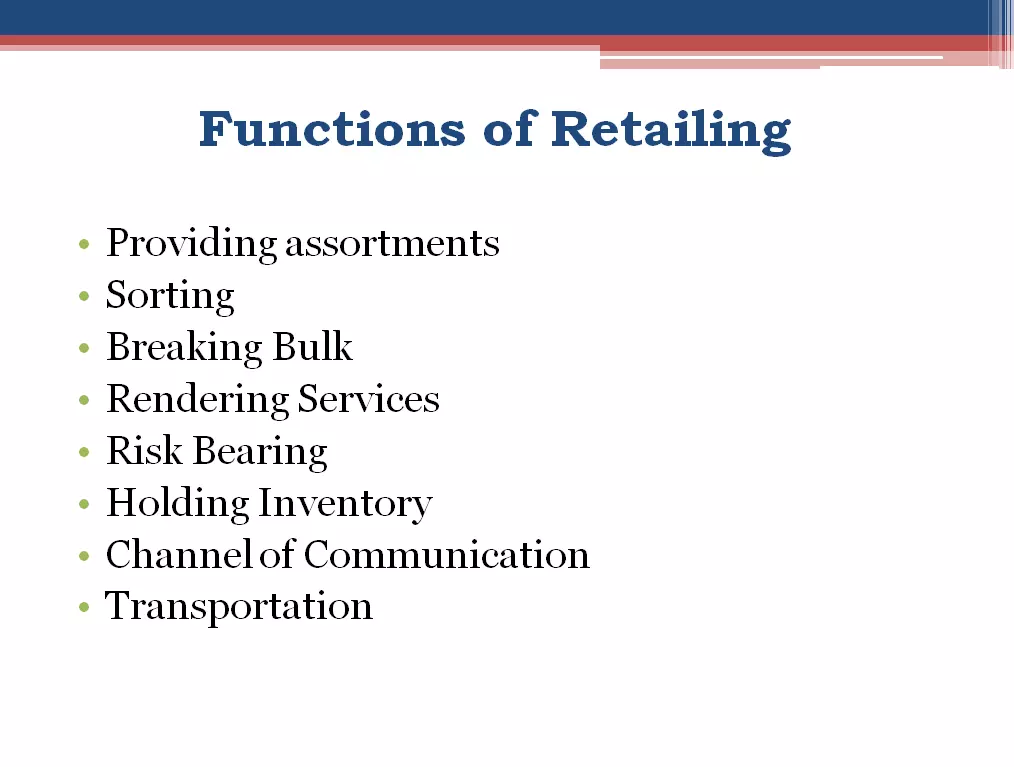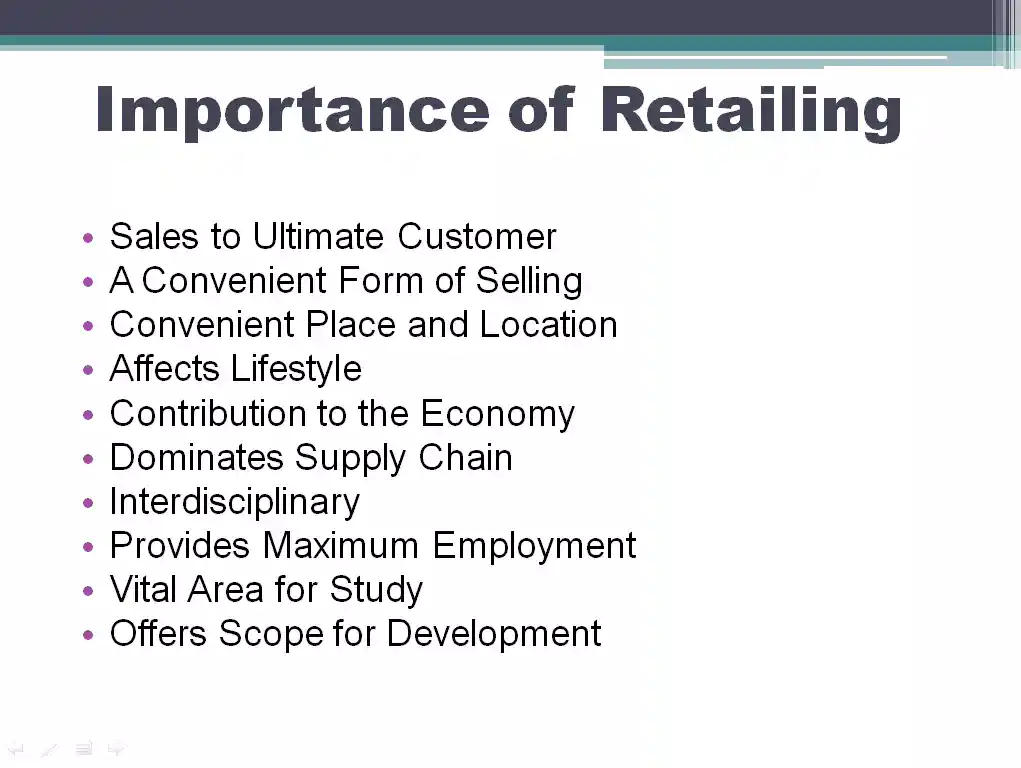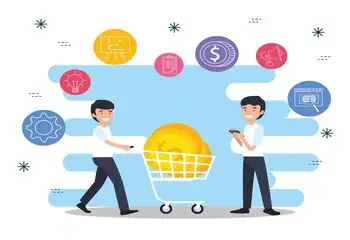Table of Contents: –
What is Retailing in Marketing?
Retailing is a global and technologically advanced industry that plays a major role in the global economy. About one in five U.S. workers is employed by retailers. Increasingly, retailers are selling their products and services through more than one channel—such as stores, the Internet, and catalogues. Companies that offer services to consumers, such as dry cleaning and automobile repairs, are also considered retailers.
Retailing is the final stage in the marketing Channel of Distribution. The term ‘retail’ has been derived from the French word “retailer” which means ‘cutting a piece’ or ‘breaking bulk.’ It covers all the activities involved in the sale of products and services. Retailing is a high-intensity competition industry and the second largest globally.
The popularity of retail stores lies in their ability to offer convenient access to a wide range of products, granting consumers the freedom to choose from multiple options and benefit themselves from various services. The size of an average retail store varies across countries primarily influenced by the level of economic development in each respective country. The largest retail store in the world is Walmart in the USA.
What is Retailing?
Retailing is the most common form of doing business. The retail business model involves the sale of merchandise in small quantities directly to consumers from a permanent location, generally a retail store. These consumers may be individual buyers or corporations.
Retailers purchase goods or merchandise in bulk directly from manufacturers and then sell them in small quantities. Shops can be found in various locations, such as residential areas, colony streets, community centers, or modern shopping arcades/ malls.
Retailing is the business activity of selling a wide range of goods and services to the ultimate consumer. It can be defined as the business products and services to consumers for their use.
Retailing is the activity of selling goods and services directly to end consumers for their personal use. Its primary objective is to ensure the smooth delivery of finished goods to customers who are willing to pay for the pleasure of eating, wearing, or experiencing particular product items.
Retailing is primarily concerned with the efficient distribution of goods and services. Retailers assume a pivotal role in the complex journey that products undertake, starting from their origin at a manufacturer, grower, or service provider, and ultimately reaching the end consumer.
Retailing is also one of the key elements of a well-crafted marketing strategy as it enables the specific targeting process, making sure that a product reaches particular groups of consumers. Retail management plays an important role in ensuring that a product effectively reaches its intended audience.
A successful marketing strategy must align the purchasing environment with the unique benefits and attributes of the product, as well as its price.
Define Retailing
According to Kotler, – “Retailing includes all the activities involved in selling goods or services to the final consumers for personal, non-business use”.
According to the American Marketing Association, – “A set of business activities carried on to accomplishing the exchange of goods and services for purposes of personal, family, or household use, whether performed in a store or by some form of non-selling.” –
It is the process of enhancing sales and customer satisfaction by gaining a better understanding of the consumers of goods and services produced by a company.
It is a most typical way of conducting business It entails selling goods in modest quantities to customers directly from a fixed location (a retail store). These customers could be business or private buyers.
Retailers buy products or items directly from manufacturers in bulk before reselling them in smaller amounts. Shops may be found on neighborhood streets, colony streets, community centers, or contemporary shopping centers.
Characteristics of Retailing
In the context of emerging markets, retailers play an important role as indispensable participants. To serve India’s expanding middle class, big brands are racing to enter the desired retail formats.
Retailers perform numerous responsibilities such as supplying assortments, sorting, breaking the bulk, rendering services, bearing risk, serving as a conduit of communication, transportation, advertisement, and holding inventory.
They make a substantial contribution to boosting the worth of the product and ensuring client satisfaction.
The duties of a retailer are listed below.
1. Sale to Final Consumer
The fact that retailing involves selling goods or services to end users is its most crucial feature. An advertising approach or a person or entity that uses or consumes something can both be considered end consumers.
It implies that the subject consumes something. They don’t purchase it, sell it, and then give it to another individual. The ultimate consumer is what we refer to as.
2. Various Channels
The downstream process, which addresses the issue of “How to effectively deliver our product to the end consumer”, includes various distribution networks. In contrast, the upstream procedure, commonly known as the supply chain, provides an answer to the query “Who are our suppliers?”.
A distribution channel serves as the pathway through which all products and services must traverse to reach their target customers. On the other hand, it also specifies the payment route that customers follow to remunerate the original service provider.
3. Small Order Size
Minimum order requirements are very sensible from the supplier’s perspective because they help them sell their inventory more quickly, generate more money, and weed out customers who are just looking for a deal. The cost of inventory for wholesalers is used to determine the minimum order amounts, which helps them maintain a profit while also boosting free cash flow. Even though wholesalers might not favour this approach, there are times when they are left with few options since manufacturers have minimum order requirements.
4. Large Number of Orders
The retailer caters to many orders dealing with its local business, this even generates lots of employment and bridges the gap between producer to consumer.
5. Keeps a large assortment of Goods
In retailing, an assortment strategy refers to the quantity of both the quantity and variety of goods made accessible for consumer purchase within physical stores. This strategic technique, often known as a “product selection strategy,” is used by retailers to effectively manage and enhance sales. The two primary components of the strategy are as follows:
-
- The range of products offered by a store or the number of varieties it carries (e.g., different sizes or flavours of the same product) plays an important role in determining its success.
-
- How many various types of things does a store carry, or the breadth (width) of its product diversity?
Retailing Meaning
Retailing is the process of executing a comprehensive series of activities or steps used to effectively and efficiently market a product or service to consumers for their personal or family use. It is responsible for matching the individual demands of the consumer with the diverse range of products offered by manufacturers.
The term “retail” originates from the French word “retailer,” which means to cut a piece off or ‘to break bulk’. The process of distributing consumer products begins with the producer and ends with the ultimate consumer. Between the producer and the consumer, there are middlemen and the retailer is the last middleman who links the producers and the ultimate consumers.
“Retailer is who directly meets end users to sell the product/services and to get feedback for producers.”
According to Cundiff and Still, “Retailing consists of all those activities involved in selling directly to ultimate consumers”.
According to Mc. Carthy, “Retailing is selling final consumer products to households”.
Thus, retailing includes all the direct sale of goods or services to end consumers for personal, non-commercial purposes. A retailer, or retail store, is a business enterprise whose sales volume comes primarily from retailing. Any organisation selling to final consumers – whether a manufacturer, wholesaler, or retailer is doing retailing. It does not matter how the goods or services are sold (by person, mail, telephone, vending machine, or Internet) or the location of sale (in a store, on the street, or in the consumer’s home), it is of no consequence.
Functions of Retailing
Retailers are important players in the emerging market scenario. Large brands are running first to get into the desired retail formats to cater to the burgeoning middle class of India. Retailers perform various functions that are essential for the smooth operation of the market. These functions include providing assortments, breaking down bulk quantities, sorting, rendering services, serving as a channel of communication, transportation, bearing risk, advertisement and effectively managing inventory. They significantly contribute to enhancing the value of the product and ensuring customer satisfaction.
 The following are the functions of retailing:
The following are the functions of retailing:
1. Providing assortments
Offering an assortment enables customers to choose from a wide selection of brands, sizes, designs, colours, and prices in one location. Manufacturers play an important role in an economy by specializing in the production of specific types of products.
Example: Kellogg makes breakfast cereals, and Knorr makes soups.
If each manufacturer had its stores that only sold its products, consumers would have to go to many different stores to buy groceries to prepare a single meal. Retailers offer an assortment of multiple products and brands for consumer convenience.
2. Sorting
Manufacturers typically produce either a single line or multiple product lines and they consistently sell their entire output to a few buyers to minimize costs. Finally, consumers prefer to choose from a large variety of goods and services and usually buy in smaller quantities.
Retailers have to strike a balance between meeting the expectations of both parties involved. This is achieved by collecting a combination of goods from different producers, buying them in large quantities, and selling them to individual consumers in smaller quantities. The above process is called sorting. During this process, the retailer undertakes activities and performs functions that add value to the products and services, ultimately facilitating their sale to consumers.
Example: Pantaloon Retail operates a renowned shopping supermarket called ‘Big Bazaar’, which offers more than 20,000 assortments from 900 companies. This one-stop destination allows customers to choose from such a basket in just one location. There are specialized retailers like Nilgiris or Barista, which offer specialized assortments of a single product line.
3. Breaking Bulk
Retailers offer products in smaller quantities tailored to particular consumers and household consumption patterns. This strategic approach reduces warehouse costs, transportation costs, and inventory costs. This is called breaking bulk.
4. Rendering Services
Retailers provide a range of services that make it easier for customers to buy and use products. They provide credit facilities to the customers. They display products, which attract customers. Retailers maintain readily available information to promptly address customer inquiries. They provide services by which the ownership can be transferred manufacturer to the end consumers with convenience. They also provide product guarantees from the owner’s side, after-sales service, and also deal with consumer complaints.
Retailers also offer credit to consumers and develop hire purchase facilities to enable them to buy a product immediately and pay the price at ease. Retailers also fill orders and promptly process, deliver, and install the product at the customer’s point. Retail salespeople answer customer complaints and demonstrate the product for the customer to evaluate before making a choice. They also help in completing a transaction and realizing the sale.
5. Risk Bearing
Retailers face a different set of risks compared to manufacturers and wholesalers. Even the customers can come back to return the product at the retail point. In that case, the responsibility of product ownership often lies with the retailers. Numerous companies offer buy-back schemes and return schemes whereby the retailers can always return the unsold items to the manufacturer.
6. Holding Inventory
One of the primary responsibilities of retailers is to effectively manage inventory so that products will be available for consumers. Thus, consumers can maintain a significantly reduced inventory of products at home because they can easily access more from nearby retailers. The retailer’s inventory ensures that customers have immediate access to a wide range of products and services.
7. Channel of Communication
Retailers serve as the vital link between the manufacturer or his representative and the end customers. They serve as a two-way communication channel. The manufacturer gathers customer choice and preference data and provides information about both existing and new products through the retailers. Point-of-purchase displays function as effective advertisements, that provide valuable information about new products.
Additionally, retailers often utilize these displays to inform consumers about the likely date of availability of a product or entry of variants into the market. The shoppers get a chance to learn about products and services from the stores and even acquire trial habits by seeing others buying a product or service in the store. The manufacturer also collects customer data, data on gaps in demand and supply cycles, and customer satisfaction from retail points.
8. Transportation
Retailers also play an important role in facilitating transportation and advertisement functions. The larger assortments are transported from the wholesaler’s point to the retailer’s point by the retailer’s arrangements and many times, the retailer delivers the goods at the final consumer’s point. So, retailers assist in the storage, transportation, and prepayment of merchandise.
Related Articles:
Importance of Retailing
Retail marketing’s significance for today’s producers cannot be emphasized. To expose businesses to a big audience and distribute items extensively, retail outlets are crucial. Retailers can interact with customers in-store (the ultimate consumers of your products). Retailers have a history of selling products to customers. He has a thorough awareness of his client’s likes and dislikes due to his regular interactions with them. He sells goods in a variety of sizes and forms and keeps inventory on hand to satisfy customer requests.

1. Sales to Ultimate Customer
In a retail transaction, the goods and services are distributed to ultimate or final purchasers. The items are not resold after this sale. The products and services offered here can be utilized for a variety of purposes, including commercial, domestic, and residential ones. The manufacturer will consequently interact with his customers through the store and find out what they think.
2. A Convenient Form of Selling
Reselling things that have been disassembled into their constituent elements is referred to as “retail.” The merchant buys the goods in bulk from the producer or middleman, and the majority is divided into smaller quantities and sold to clients according to their requirements. To accomplish this, the shop will repackage products in various quantities and varieties, making it simpler for customers to choose and transport them.
3. Convenient Place and Location
Shops for retailers are frequently situated in places that are simpler for clients to get to. A retail establishment can come in a variety of shapes and sizes, including a coffee shop, a tiny store, or a multiplex. Whenever they want, consumers may buy and sell products via mobile apps and the internet.
Additionally, internet shopping is becoming a contemporary trend because of developments in technology and delivery methods. As a result, an increasing number of companies are shifting their activities online, making it possible for customers to access and buy products from the comfort of their homes.
4. Affects Lifestyle
The retail industry is crucial to today’s culture. To live comfortably, people rely largely on retail establishments. Previously, the trading mechanism was used to make goods and services available. Today, however, the buying and selling of goods has taken the role of trade, making retail establishments a necessary component of society.
5. Contribution to the Economy
A significant portion of the Gross Domestic Product (GDP) in many nations comes from the retail sector. Its contribution has grown considerably in recent years and is still expanding quickly. An important economic force that can support long-term growth is retailing.
6. Dominates Supply Chain
In a supply chain, products and services move from a store or a distributor to the ultimate consumers. The location of retail establishments becomes even more crucial when there are numerous consumers dispersed across the globe. Retailers act as a middleman between producers and final consumers.
7. Interdisciplinary
Retailing has evolved with the help of economics, geography, management, economics, and marketing. A store’s financial management is aided by economics. Choosing the ideal location for a shop requires a solid grasp of geography. Proper management is essential for managing your staff and merchandise, and it’s equally important for helping you break into the market.
8. Provides Maximum Employment
Presently, the retail sector stands as the largest employer in the workforce. One in nine people are reportedly employed in the retail industry. Additionally, two-thirds of the retail workforce is made up of women, and more than half of all retail employees work part-time, allowing them the flexibility to meet any employer’s demands.
9. Vital Area for Study
Retailing is getting more and more attention due to its growing popularity. The study of retail is different from that of marketing and management. Studies have been conducted and specialists have been enlisted to help this industry prosper. Additionally, academic publications that concentrate on retailing are available anywhere in the world.
10. Offers Scope for Development
Retail provides a great opportunity to venture into global markets. To increase the number of individuals who purchase their goods, a retailer who wants to diversify their market by selling their goods abroad creates stores there.
